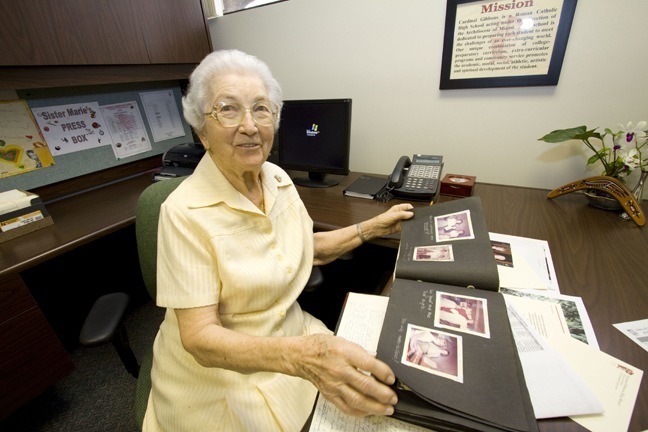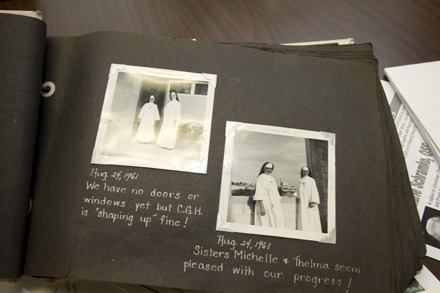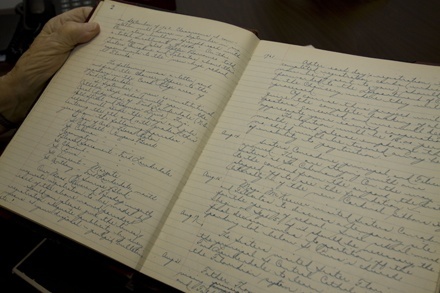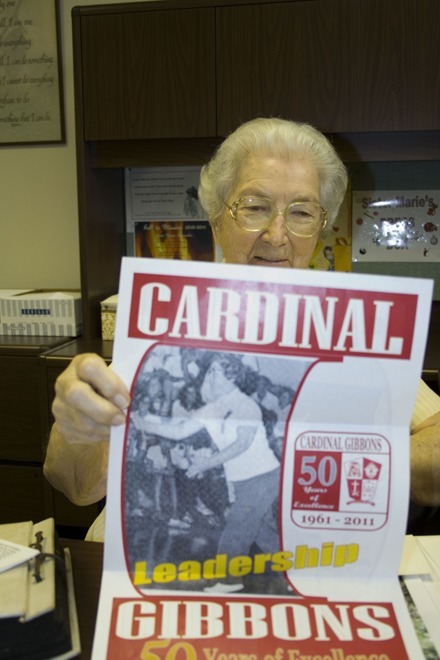By Ana Rodriguez Soto - The Archdiocese of Miami

Photographer: ANA RODRIGUEZ-SOTO | FC
Sister Marie Schramko looks over the scrapbook she created showing the growth of Cardinal Gibbons High School over the years, from the time there were no buildings - but classes still went on - to the fully-developed campus that exists today.

Photographer: ANA RODRIGUEZ-SOTO | FC
"We have no doors or windows yet, but CGH is shaping up fine!" says this scrapbook entry from August 1961. Sister Schramko, wearing a full habit, is on the left.
�The reason I wrote this is I wanted people to know. We weren�t handed a beautiful building. We had no building. But we did whatever we had to do,� she said while sitting in her immaculately-ordered office just before the start of her 50th year at the school � and her 75th as a religious.
She had been a member of the Franciscans of Mary Immaculate for 27 years, a veteran teacher and administrator of schools in Chicago, Jolliet, Ill., and Toledo, Ohio when her mother superior told her, �Sister, I�m going to send you to Miami.�
The date was July 20, 1961. She was actually going to Fort Lauderdale. Classes were set to start Sept. 5 � and they did, even though the buildings were not finished.
�This was all sand. No lights. No telephone,� Sister Schramko recalled. �We had no water. We had no lavatories � If we wanted to go to the lavatory we drove over to Holy Cross Hospital,� which is located several blocks west on Commercial Blvd. The boys and girls went in �port-a-potties.�
Sister Schramko became the founding principal of the girls� division of the co-institutional school. The boys� division was led by a Piarist priest, Father Henry Mirowski, and the supervising principal for both was a diocesan priest, Father Thomas Dennehy.

Photographer: ANA RODRIGUEZ-SOTO | FC
Sister Marie Schramko shows the neatly-handwritten pages of the journal she has kept every year since 1961, when she arrived to staff the girls' side of Cardinal Gibbons High School. "Someday they'll want to know how we started," she thought.
So the boys and girls shared one floor of the girls� building � two rooms divided by a rudimentary partition. Thankfully, the contractor was a man they dubbed �50-day Collins� because �within 50 days he completed the boys� building,� Sister Schramko said.
Then there was the matter of getting the girls some privacy when they changed for physical education. Sister Schramko asked for some drapes to cover the windows. She was given damaged hand-me-downs from a hotel.
�We sewed them together,� she said, adding that one girl �was so thrilled. She had never done anything like that before.�
Physical education, at that point, meant �we would go out and pick up rocks and clear land,� said Sister Schramko, who taught that for one semester.
She recalled planning a school dance � �I always wanted them to feel like they were in a high school� � and having some girls come up to her convinced it would be a disaster because the boys would never ask them to dance.
Sister Schramko bet that the boys would. The price of losing: �I want some grass,� she told them. The next day, three girls came in, each bearing a piece of sod. �If you were good, you were allowed to water it, but you didn�t dare to step on it.�
Speaking of landscaping, �There was one boy, I wondered how he was ever going to graduate, because whenever I saw him he was on a tractor putting in a tree,� Sister Schramko said.
Circumstances dictated that everyone had to pitch in to get the school off the ground, and those lessons were incorporated into the curriculum.
�When we started out, they saw that we had nothing. Whatever we did, we did with the kids,� Sister Schramko said. �If you wanted something to succeed, you had to do everything you possibly could. We tried to embed that into the students. Maybe not verbally, but just seeing what we were doing.�
It is one of the lessons that stuck, especially with the earlier graduates.
�We really vested a lot in the school,� said activities director Carlos Perez-Cubas, a 1979 graduate who has worked at the school since 1983. �What a bonding experience for the kids, to do physical, manual labor.�

Photographer: ANA RODRIGUEZ-SOTO | FC
The 50th anniversary poster for Cardinal Gibbons High School features a picture of Sister Marie Schramko playing volleyball with the students during an assembly. "I had a pair of jeans on me and of course the kids were just astounded," she recalled.
He said it took him a while to get used to working with Sister Schramko as a faculty member rather than a student.
�All she had to do was give that stare. She was a force to be reckoned with,� said Perez-Cubas, who learned algebra from Sister Schramko. �When I started teaching here and I got a note to come and see her � I started trembling.�
He has since learned that �she has a tremendous sense of humor � off the charts.�
That�s evident when Sister Schramko tells the story of how the girls were initially not allowed to use the gym. �So we changed that,� she says simply.
Then there was the time �I surprised them all at an assembly. I went out and played volleyball. I had a pair of jeans on me and of course, the kids were astounded.�
The picture of her playing that day now adorns the poster announcing the school�s golden anniversary.
Sister Schramko also is known for attending every athletic event, according to Ryan Saunders, a 2002 graduate. �She sits out in the bleachers with her umbrella and is at everything.�
�I loved football and I loved baseball,� said Sister Schramko, who was raised in �a little mining town,� Johnstown, Penn., with two older brothers and two younger sisters. �We didn�t have too many opportunities (to play sports) like the girls have today.�
Over the past 50 years, she has continued to teach while serving as assistant principal, a position she assumed when the school became co-educational in 1972. Over the years, she has taught algebra, geometry, biology, chemistry and Latin.
�She has more certifications than any teacher,� said Gail Breton, also an assistant principal at Gibbons. �She told me that whenever they needed a teacher, she went back and took more classes and got the degree.�
This year, for the first time, Sister Schramko will not teach a class but will continue to tutor students who need extra help.
She can no longer climb to the top of the stands, but she plans to be at every game, supporting Gibbons� athletes.
As she has done every morning for the past 45 years, she will continue to walk across the street to her office from her home � the only one in existence in that neighborhood when the school was founded, the one that still serves as a convent for her and Sister Janet Rieden, a fellow Franciscan who has taught at the school since 1963.
If anybody asks Sister Schramko a question, such as how many students were in the first graduating class, or how many have graduated in all the years the school has existed, she will walk over to her filing cabinet or her journals and put her fingers directly on the answers: 64 and 11,374, respectively.
And when former students come visiting, she will be happy to welcome them back, because �I�m very interested in how our students turn out, how they�re using their lives.�
�I never knew I was going to live this long,� Sister Schramko said. �Did I have fun? Oh, yes. I enjoyed it. I played with the kids.�
Morever, she added, �I have no desire to retire. When I wear out, I wear out.�

